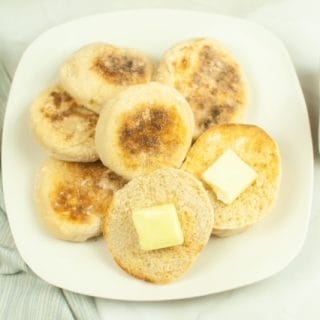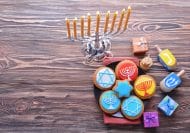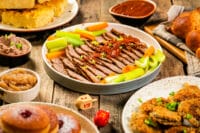
Looking for a delicious breakfast treat? Check out this recipe for homemade English muffins! Made with simple ingredients and easy to follow instructions, these muffins are sure to be a hit with your family and friends. Crispy on the outside and soft and fluffy on the inside, they are perfect for toasting and slathering with butter or your favorite jam.
Did you know the English Muffin was invented right here in the United States. Yes, Samuel Bath Thomas was from England, but he immigrated to New York and they were invented there.
An English muffin dough is wetter than a bread dough and there are many different techniques to forming them. I actually use different methods although the one below is my favorite as it is simple. Mine are not all uniform, but I don’t have the desire or time for that since they turn out delicious each time.

What makes an English Muffin an English muffin?
The dough and cooking method is what sets the English muffin apart from other breads. The dough is wetter and more firm.
Cooking them on a griddle is another difference and sometimes when I am in a hurry, I will grill the outsides and then pop them in a 300 degree oven for 10 minutes to finish.

Reminders When Baking English Muffins
Never cut – open with a fork!
Using a fork to open English muffins is a common technique that helps to create the signature nooks and crannies that make English muffins so unique. When an English muffin is split open with a knife, it can compress the dough, which can result in a denser texture and a less distinct crumb.
Using a fork, on the other hand, allows you to gently pull the two halves of the muffin apart, creating a rough, textured surface that is perfect for trapping butter, jam, or any other delicious toppings you might want to add. This method also helps to create a more even split, which can make it easier to toast the muffins evenly.
To open your English Muffins, poke the fork into the muffin all the way around until it pops open.
Always toast!
Toasting English muffins is an essential step in bringing out their full flavor and creating their signature texture.
English muffins have a dense, chewy texture that can sometimes be a bit tough to chew. Toasting them helps to soften the interior.
Toasting English muffins can help your favorite toppings, such as butter or jam, adhere better to the surface, creating a more even distribution of flavors.

How to Make English Muffins
Prep time: 20 minutes
Cook time: 10 minutes per batch of muffins
Proof time: 2 hours total
Yields 16
Ingredients:
- 2 1/4 tsp active dry yeast
- 2 tbsp sugar, granulated, divided
- 4 1/2 cups flour, all-purpose, divided
- 1/4 cup water, warm, 110 degrees
- 1 egg, large
- 1 3/4 cups whole milk
- 3 tbsp butter, salted
- 1 1/2 tsp salt
- 1/2 cup cornmeal

Instructions:
In a measuring cup, combine the yeast, 1 tablespoon of sugar, and the water. Stir gently and let sit for 5 minutes until foamy.

Add the proofed yeast to a mixing bowl with the egg, milk, melted butter, salt, remaining sugar, and 2 cups of flour. Mix until smooth.

Add the remaining flour and use a dough hook on a stand mixer for 5 minutes, or your hands on a floured surface, for 10 minutes. Your desired dough should be manageable, but sticky to the touch. Don’t over-flour the dough.


Move the dough to an oiled bowl and cover to proof for 1 hour, or doubled in size, in a warm place. I like to set my oven to 100 degrees Fahrenheit. Once at that temperature, turn off the oven, and place the covered dough in the oven.

Once proofed, punch the dough, and pour it out onto a floured surface.

Divide into 16 even pieces.

Sprinkle flour on your hands and roll the dough into balls.
Place the raw muffins onto baking sheets that have been sprinkled with cornmeal. Press with the palm of your hand on the dough to form “pucks” so they resemble English muffins. Sprinkle the tops with cornmeal as well.

Allow these to rise for another 60 minutes. Cover with a clean cloth.
With your cast iron skillet on medium-low heat, transfer your English muffin. Place as many as you can in the cast iron (or skillet) without crowding. Cook on one side until golden brown (about 5 minutes). Flip and cook until golden brown (about 5 minutes). Might take longer if not using cast iron.


Transfer to a cooling rack or serving dish! Enjoy as a breakfast sandwich, or toasted with butter!

Due to the set up and baking of English muffins, I bake a double portion each time. They store well in plastic containers or plastic bags. You can store in the refrigerator and freezer.
These are a staple in our home and once you make them a time or two you will see it takes no time at all and you will get your own method down.

Can I make English muffins Sourdough?
YES! And they are delicious. Actually the original English muffins were sourdough. When I make them sourdough I actually use a yeast packet and about 1/3 cup of my sourdough starter. This means I cut the milk down about 2 tablespoons and only add if needed.
Can I warm my English muffin on the griddle?
Yes, you can warm it on a griddle but I suggest buttering it first. I do it this way when I have a crowd or making eggs benny.
Why are English muffins used in Eggs Benedict?
First of all- Eggs Benedict is one of my favorite foods. While I do not know why traditionally- I can say I believe it is due to the nooks and crannies and the delicious egg yolk having the perfect place to soak into.

Homemade English Muffins
Ingredients
- 2 1/4 tsp active dry yeast
- 2 tbsp sugar, granulated, divided
- 4 1/2 cups flour, all-purpose, divided
- 1/4 cup water, warm, 110 degrees
- 1 egg, large
- 1 3/4 cups whole milk
- 3 tbsp butter, salted
- 1 1/2 tsp salt
- 1/2 cup cornmeal
Instructions
- In a measuring cup, combine the yeast, 1 tablespoon of sugar, and the water. Stir gently and let sit for 5 minutes until foamy.
- Add the proofed yeast to a mixing bowl with the egg, milk, melted butter, salt, remaining sugar, and 2 cups of flour. Mix until smooth.
- Add the remaining flour and use a dough hook on a stand mixer for 5 minutes, or your hands on a floured surface, for 10 minutes. Your desired dough should be manageable, but sticky to the touch. Don’t over-flour the dough.
- Move the dough to an oiled bowl and cover to proof for 1 hour, or doubled in size, in a warm place. I like to set my oven to 100 degrees Fahrenheit. Once at that temperature, turn off the oven, and place the covered dough in the oven.
- Once proofed, punch the dough, and pour it out onto a floured surface. Divide into 16 even pieces.
- Sprinkle flour on your hands and roll the dough into balls.
- Place the raw muffins onto baking sheets that have been sprinkled with cornmeal. Press with the palm of your hand on the dough to form “pucks” so they resemble English muffins. Sprinkle the tops with cornmeal as well.
- Allow these to rise for another 60 minutes. Cover with a clean cloth.
- With your cast iron skillet on medium-low heat, transfer your English muffin. Place as many as you can in the cast iron (or skillet) without crowding. Cook on one side until golden brown (about 5 minutes). Flip and cook until golden brown (about 5 minutes). Might take longer if not using cast iron.
- Transfer to a cooling rack or serving dish! Enjoy as a breakfast sandwich, or toasted with butter!

I am a home cook that does things my way. In my kitchen, I make breakfast, pack lunches, prepare snacks, and cook dinner. During the week, we eat real food that is homemade, organic, and local. On the weekends we do explore more of our local restaurants. I bake my own bread, juice fresh oranges every other day, and make my own kombucha and other weekly favorites.











